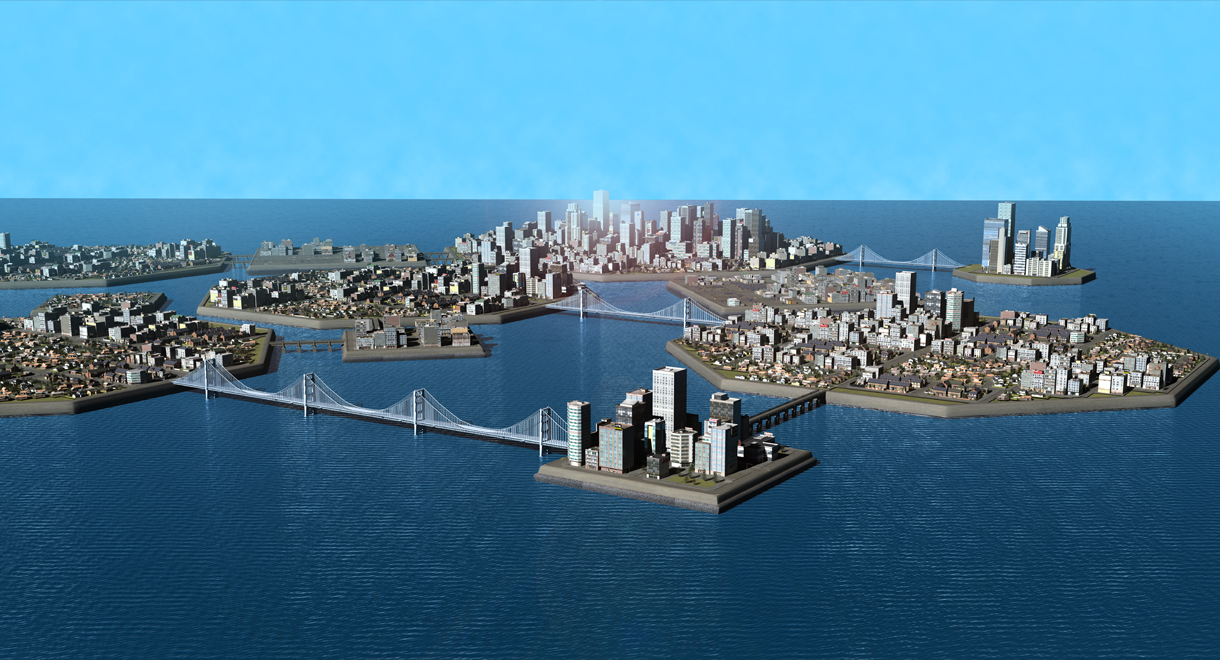Issues
Water on the Rise: Policies for Coastal Plains
- Details
- Published: Friday, 02 October 2015 21:17
- Written by Christopher A. Wilson
- Hits: 18451
A potential sea level rise in coastal areas such as Miami, Norfolk, and New York City threatens the population’s economic and social status quo. Engineers, policymakers, and emergency managers, are encouraged to rethink their approach to mitigating the risk from hurricanes, storm surge, and the potential of elevated sea levels. The state of Louisiana, in general, is one of the regional economic hubs for energy production, infrastructure distribution and international and domestic trade; nevertheless, the loss of land over time due to sea level rise and hurricanes is threatening infrastructure in this coastal area.
Engineers can use the environment and technology to adapt to changes in the environment. The author promotes the idea to build floating cities, which would use solar energy to produce electricity and recyclable seawater to produce freshwater. Funding for such projects would come from public-private partnerships utilizing limited recourse or non-recourse financing. Investing in a floating city concept would save the money that would have been invested in levee systems upgrades, protecting the city from flooding, and creating larger ports that encompass greater services to assist with the distribution system. Therefore, implementation of the floating city project can put the coastal people and the infrastructure out of danger, and hence, ensure social and economic stability.
Introduction
© Copyright, Potomac Institute Press
Sea levels are rising throughout the world, in different amounts in different regions. Coastal communities are vulnerable to social, security and economic issues; the consequential flooding, hurricanes and storm surges endanger their lives and property. There is a need to protect coastal communities from the devastating effects such as those seen during Katrina, which is still struggling to recover a decade later. The rise in the sea level is driven by a variety of factors; the first is melting of glaciers, which is assessed by determining the height of the water as measured along the coast relative to a point on land. Other factors include tectonic factors that change the profile of ocean basins, storms, tides and climate change which influences the density and amount of ocean water.
The changing heights of land (subsidence or uplift) and ocean have caused an irregular change in the sea level. The sea level is rising faster in some locations, like in New Orleans, than the global average while, in other regions, such as Alaska, it may be falling. Estimating present and future local rates of relative sea level change for specific areas based on observations and projections of global sea level rise allows coastal engineers and policy makers to study and strategize for the impacts for efficient mitigation.1 Subsequently, land use decisions should consider lessons learned from the mitigation efforts employed in vulnerable areas.
The study of sea level rise is a large field. We state many facts and statistics as reported by our references.
Coastal impacts
After the 1927’s Great Flood in Louisiana, the United States Army Corp of Engineers built levees to protect communities living in the delta of the Mississippi River. Historically, in the case of New Orleans, wetlands, barrier islands, and dunes have played a significant role in protecting coastal wetlands. But salt water from the ocean moving into fresh water wetlands has degraded the defense to coastal areas. As a result, many coastal areas along Southern Louisiana Coastline are vulnerable to storm surge and future hurricanes. Today the region faces new challenges, both outside the levee walls from rising seas and inside from land subsidence and regular flooding.2 Many other coastal communities such as Miami, Florida, Norfolk, Virginia, New York City, and New Jersey, face a similar threat.
Norfolk is residence to the United States chief naval facility, but is facing multiple threats from storm surge, coastal inner city flooding, and elevated sea levels. The land is still sinking in connection with the Chesapeake Bay Impact Crater that was left over from an asteroid impact 35 million years ago.3 The total tally of flooding occurrences in Norfolk have tripled every year since the 1970s while tidal flooding happened approximately once per month. The predicted sea level rise at Norfolk is six inches by 2030. By then, the city could have 40 tidal flooding events per year.4 In addition to tidal flooding, many tunnels and roads are closed when high tide occurs, impacting emergency evacuation routes.5 Nevertheless, Norfolk is in partnership with the Rockefeller Foundation to build elevated roads, tide gates, floodwalls, and pumping stations. The cost is expected to exceed $1 billion. Miami has a similar problem.
In Miami, a majority of citizens live in flood plain areas. Most of the existing land does not accommodate future sea level rise or storm surge. Currently, the geology of Miami is made up of Limestone soil, equated by engineers to Swiss cheese, which has caused salt water from the ocean to destroy fresh water aquifers. The cost of keeping seawater off the streets in Miami is expected to cost $400 million over the next 20 years.6 New Orleans has an even bigger problem.
In New Orleans, drainage pipes become overwhelmed with inner-city flooding caused by heavy rainfall. New Orleans and areas along the Southern Louisiana coastline are fighting the epic battle of subsidence. According to Waggoner & Ball Architects,7 subsidence is the sinking of ground that damages infrastructure like roads, pipes, and buildings. Subsidence will cost the state of Louisiana an estimated $2.2 billion dollars for repairs to infrastructure over the next 50 years. In a report by Marshall,8 it is noted that 60 percent of the residents of the metropolitan area live on land lower than the lake’s surface. Despite investment of millions of dollars in levees, the city is still sinking. New methods are needed to protect New Orleans and other coastal communities.
New solution for protecting coastal communities
Engineers and architects have a new vision that embraces living with rising water. Instead of fighting the very threat that many coastal communities face, coastal communities should adapt and make use of the environment. According to Paul Lewis of Princeton University, every house that is located near water can be viewed as a waterfront house.9 Guy Nordenson, also at Princeton, rejects the notion of a dividing line between land and sea. His approach calls for amphibious suburbs with landscape that could sustain periodic flooding. In addition to the amphibious suburbs, Nordenson is encouraging a reconsideration of the FEMA flood zone boundaries that ultimately determine insurance rates and building code requirements. Geographical areas that are prone to flood risk should be assessed on the outcomes and probabilities of diverse storm events, not the protection afforded by artificial levees that can be overtopped by high storm surges.10
Nordenson further calls for revitalizing natural wetlands and beach dunes. This approach has the potential to reduce the impact of waves, improve water quality, and allow for recreational areas to be created along coastal communities. And then there is the concept of floating the city of New Orleans. Environmental engineers and architects have produced computer simulations, but no one has yet tested the concept.
In general, the idea is to quit fighting the rising sea, but rather to build communities that can adapt to it.
Accordingly, a 21st Century concept for adaptation involves building infrastructure on top of floating platforms near coastlines. This fanciful idea is more practical than one might think. Of course, the underlying infrastructure would be costly. However, compared to fighting the rising sea with barriers and pumps and overbuilt drainage systems, the concept might be considered affordable. The state of Louisiana estimates a price tag of $9 billion dollars to build a floating city equivalent to the Dutch approach in Amsterdam.11
One possibility for financing the development of floating infrastruction would be to use public/private partnerships. “Public Private Partnerships” is a funding concept being embraced by state and local communities. The Public Private Partnership Infrastructure Resource Center defines them as government instruments to acquire and implement public services or infrastructure using the knowledge, resources and skills from the private sector.12 A partnership with the private sector can assist with innovation by providing new finance opportunities.13
Each city would need to execute an economic development strategy adapted to the unique city’s experience according to the type and extent of sea level rise. Plans would be adapted to the risk of future events, both catastrophic and gradual, and thus “buy-down” risk. The plans would take into account expected sea-level-rise, restoration of surface water, and hydrology, and the need to lessen the danger of salt water intrusion.
Obstacle or challenges coastal communites may face to becoming resilient
A floating city can have homes, schools, businesses, roads, infrastructure, sewage systems, etc., just like any other city. The difference is that floodwaters from rain and storm surge are no longer great threats. The floating city will have to worry about maintenance and corrosion, but is no different from land-based cities. Accrued cost savings from the comparison with post-disaster recovery and flooding cleanup can be 4 to 10 times more expensive than the mitigation efforts for the same hazards before they occur.14 Those mitigation efforts, in turn, are as expensive or more expensive than building floating cities with more resilient designs.
There could be legal issues if floating cities cause deterioration of adjacent shores due to erosion or other causes.15,16 The main obstacle, however, is the need to finance prevention as opposed to crisis response that might come decades later. Accordingly, realistic projections and insurance costs can help motivate resilience measures; there are indications that federally financed flood insurance rates have given home owners a poor warning of the actual risks of living by the sea.17 Better projections require good science, with good estimates of the uncertainties.
Conclusion
The impact of coastal sea level rise is a gradual threat that may transpire over decades. But as engineers, policy makers, and emergency managers have learned from the past, action now can protect the future. Coastal communities such as Norfolk, Miami, New York, and the Jersey shore are already being impacted by high tides, storm surge, and elevated sea levels. Fighting against the mounting threat using new designs and new technologies, including the concept of floating cities, will enable coastal communities and businesses to continue to thrive economically and socially in a more resilient way.
Notes
- Harvey Ruvin, et al. Miami-Dade Sea Level Rise Task Force Report and Recommendations. July 1, 2014.
- Waggonner & Ball Architects. Greater New Orleans Urban Water Plan. (2013).
- Climate Central. “Facts and findings: Sea level rise and storm surge threats for Virginia,” (2014) and “Surging Seas” by Climate Central (accessed Sept 24, 2015).
- Union of Concerned Scientists. “Encroaching tides: How sea level rise and tidal flooding threaten U.S. East and Gulf Coast communities over the next 30 years,” Authored by Spanger-Siegfried, E., M.F. Fitzpatrick, and K. Dahl. Cambridge, MA: Union of Concerned Scientists Oct 2014, Accessed Sept 24, 2015.
- Ibid, p 44.
- Christina Veiga, “Miami Beach to spend up to $400 million to deal with flooding issues,”Miami Herald. Feb 12, 2014.
- Waggonner & Ball Architects.
- Bob Marshall, “Special report: How New Orleans is making a ‘serious problem’ worse with its levees, pumping stations,” March 1, 2015, in The New Orleans Advocate, (Retrieved 13 April 2015.)
- Molly Sharlach, RESILIENT SHORES: After Sandy, climate scientists and architects explore how to co-exist with rising tides. (Nov 14, 2014,) News at Princeton, Retrieved April 15, 2015.
- Catherine Zandonella, “After Hurricane Sandy, climate scientists and architects explore how to co-exist with rising tides,” in Phys. Org, (Jan 6, 2015).
- Bob Marshall, “Special report.”
- World Bank. “What are Public Private Partnerships? Public Private Partnerships Resource Center,” Aug 2015. Accessed Sept 24, 2015.
- World Bank. “Main Financing Mechanisms for Infrastructure Projects,” (May 2015). Public Private Partnership in Infrastructure Re- source Center.
- Susanne C. Moser, S. Jeffress Williams, and Donald F. Boesch, “Wicked challenges at land’s end: Managing coastal vulnerability under climate change,” in Annual Review of Environment and Resources 2012. 37:51–78.
- Siders, A.. “Managed coastal retreat: A legal handbook on shifting development away from vulnerable areas,” © New York, NY: Columbia Center for Climate Change Law, Columbia Law School. Oct. 2013. Accessed Sept 24, 2015.
- Wes Shaw, “Storm Smart fact sheet 2: No adverse impact and the legal framework of coastal management,” Boston, MA: Massachusetts Office of Coastal Zone Management. April 2008, Accessed Sept 24, 2015.
- Union of Concerned Scientists. “Overwhelming Risk: Rethinking Flood Insurance in a World of Rising Seas,” August, 2013. (Accessed December 23, 2013.) Report authored by Rachel Cleetus.
Christopher Wilson joined the Department of Homeland Security in July 2011 as a management program analyst and has served as an adjunct online instructor at Georgia Military College




